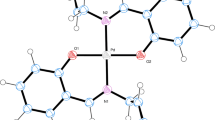Abstract
The range of oxidation states for a given element is determined by its highest and lowest oxidation states; the range is numerically equal to the difference between these highest and lowest values, and ford-transition metals may be assumed to be a value from 0 to 10. The oxidation states known at the present time for elements of the first twelve groups of the periodic table are used to plot diagrams reflecting the three-dimensional nature of the periodic table. The ranges of oxidation states are minimum for elements of the 1st, 2nd, 3rd, and 12th groups, and maximum for elements of the 6th, 7th, and 8th groups. The oxidation states above 2+ are stabilized by complexation with donor ligands, while zero and negative oxidation states are observed only in complexes with donor-acceptor ligands. The oxidation state 1+ occupies an intermediate position in this scheme.
Similar content being viewed by others
References
C. K. Jorgensen, Oxidation Number and Oxidation States, Springer, Berlin (1969).
J. Bendix, M. Brorson, and C. E. Schatter, in: Coordination Chemistry. ACS Symposium Series 565, Washington DC (1994), pp. 213–225.
K. B. Yatsimirskii, in: Coordination Chemistry. ACS Symposium Series 565, Washington DC (1994), pp. 207–212.
K. B. Yatsimirskii, Zh. Neorg. Khim.,36, No. 8, 2010–2022 (1991).
K. B. Yatsimirskii, Bull. Pol. Acad. Sci. Chem.,42, 299–305 (1994).
R. H. Crabtree, The Organometallic Chemistry of the Transition Metals, Wiley, New York (1988).
G. J. Leigh ed., International Union of Pure and Applied Chemistry. Nomenclature of Inorganic Chemistry: Recommendation 1990 (“Red Book”), Oxford, Black Well Scientific Publication (1990).
H. Jacobsen, H.-B. Kraaftz, T. Ziegler, and P. M. Boorman, J. Am. Chem. Soc.,114, No. 20, 7851 (1992).
F. A. Cotton and G. Wilkinson, Advanced Inorganic Chemistry, Fifth Edition, Wiley, New York (1988).
P. L. Arnold, F. G. N. Cloke, P. B. Hitchcock, and J. F. Nixon, J. Am. Chem. Soc.,118 No. 32, 7630–7631 (1996).
C. K. Jorgensen, in: Coordination Chemistry, ACS Symposium Series 565, Washington DC (1994), pp. 226–239.
W. Beck, Angew. Chem. Int. Ed. Engl.,30, 168 (1991).
J. E. Ellis, Adv. Organomet. Chem.,31, 1 (1990).
Yu. M. Kiselev, N. S. Kopelev, V. I. Spitsin, and L. I. Martynenko, Dokl. Akad. Nauk SSSR,292, No. 3, 628–631 (1987).
Yu. M. Kiselev, N. S. Kopelev, and A. P. Bobylev, Zh. Neorg. Khim.,34, 2654–2658 (1989).
C. K. Jorgensen, Chem. Phys. Lett.,3, 380–382 (1969).
T. Kruck, Angew. Chem.,79, 27 (1967).
H. Jun, V. G. Young, and R. J. Angelici, J. Am. Chem. Soc.,114, No. 25, 10064 (1992).
A. A. Tumanov, V. N. Prusakov, and Yu. I. Drobyshevsii, Dokl. Akad Nauk SSSR,291, No. 1, 125 (1986).
K. B. Yatsimirskii, Teor. Éksp. Khim.,31, No. 3, 181 (1995).
Additional information
L. V. Pisarzhevskii Institute of Physical Chemistry, National Academy of Sciences of Ukraine, 31 Prosp. Nauki, Kiev 252039, Ukraine. Translated from Teoreticheskaya i Éksperimental'naya Khimiya, Vol. 33, No. 5, pp. 284–290, September–October, 1997.
Rights and permissions
About this article
Cite this article
Yatsimirskii, K.B. Ranges of oxidation states ford-transition metals in their complex compounds. Theor Exp Chem 33, 248–253 (1997). https://doi.org/10.1007/BF02522705
Received:
Issue Date:
DOI: https://doi.org/10.1007/BF02522705




